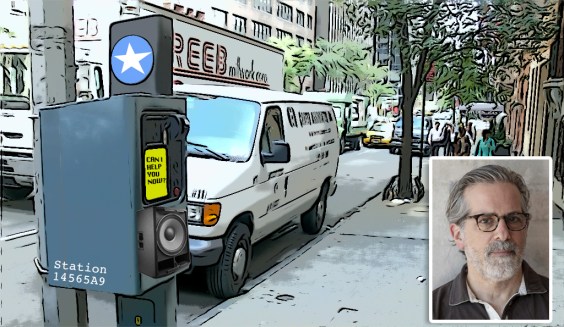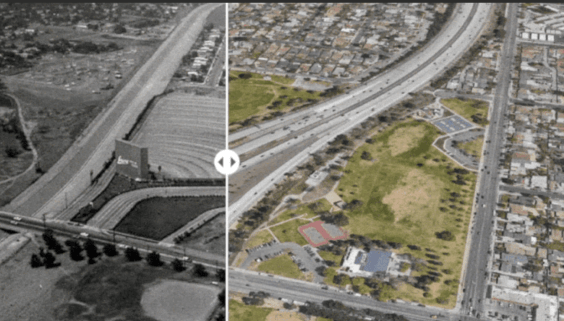 The vibrations and rumble of cable cars used to occur on many of San Francisco's streets.
The vibrations and rumble of cable cars used to occur on many of San Francisco's streets.We are often attracted to city life for the energy, the boisterousness, the noise. I am a city guy having lived all my life in cities (born in Brooklyn, Chicago until age 10, Oakland until 17, and San Francisco since I was 20). I often make the joke that "nature is trying to kill me," when one of my friends suggests we go camping. Back in the late 1970s and early 1980s I was a punk rock fan, and went to dozens of shows with ear-splitting volumes. I've been to plenty of other events through the years with overwhelming noise, from other concerts to major sports events, etc. Maybe that's why I have had a ringing in my ears for the last two years (tinnitus). And perhaps not surprisingly, I've become increasingly frustrated at the oft-overlooked urban problem of noise pollution.
 The roar of approaching motorcycles drowns out all conversation until they're well past.
The roar of approaching motorcycles drowns out all conversation until they're well past.There are many specific contributors to our unnecessarily noisy
environment, from the incessant sirens of emergency vehicles to the
mechanized roar of the early morning garbage trucks, to the always
galling car alarm serenade.
San Francisco's streets, however, are not that noisy compared to say, New York City. Or even compared to what it must have been like in the early decades of the 20th century when the City was criss-crossed by streetcars. Our cable cars are good examples of the kind of noisy transit that used to dominate the streets. For those who live along the tracks of the J-Church or N-Judah, or the cable cars, they know well how noisy a "light rail" vehicle can be.
Transit and street noise is taken largely for granted. We know it takes mechanical devices using fossil fuels to carry us around, unless we've embraced bicycling.
For us cyclists, the sounds of our whirring wheels and gentle gear changes is a pleasant confirmation of our self-propulsion. One of my favorite aspects of Critical Mass is the completely altered soundscape that accompanies our progress through the City. Sure, sometimes we're hooting and hollering, and there are at least a half dozen folks who might show up with serious sound systems pumping loud tunes into the air (a side note: the SFPD ticketed all the sound systems last month for lack of sound permits in their ongoing war of attrition, trying to literally raise the price for participating in CM). But the majority of time the sound is that of rolling bikes, murmuring voices, tinkling bells, and laughter. It's such a lovely kind of quiet, full of life and sweet energy, but so different from the anonymous, unaccountable thrumming of machines that fills our ears so often that we frequently stop noticing until they are turned off. And once you've ridden through the city in a mass of bicycles, it's hard not to remember that different urban environment, and wonder why it can't be more like that all the time.
One of the pleasures of a vibrant street life is the serendipitous encounter with street artists or performers, whose work is often dependent on the availability of a quieter public space. I had the pleasure in 1980 of running into Jean-Francois Batellier on the streets of Paris, France, one of the more prolific street artists there at the time (he appears in the car-free plaza in front of the Centre Pompidou daily to vend his drawings, books, postcards etc.) A lot of his work speaks to the alienation of modern life, the destruction of the urban fabric, and specifically a lot of great cartoons addressing the car culture. I got his book at the time, and one of his pieces stayed with me all these years:
 By Parisian street artist Jean-Francois Batellier.
By Parisian street artist Jean-Francois Batellier.I really hate the motorcycle that you hear from blocks away. As it approaches, sidewalk conversation has to stop since no one can yell loud enough to be heard over the roar of the engine. The motorcycle has to be a full block away before anyone can even try to resume talking in a normal voice. Many Streetsblog readers are enthused about the new public plazas, mini-parks and parklets that are finally getting a local tryout. I love them, and see in them a harbinger of a more convivial, friendly, sociable city. But in this awkward interim period before they're fully developed, and while the preponderant use of local throughways is still overwhelmingly automobiles, we sit in our new parklets next to traffic, the sonic environment dominated by internal combustion engines (not to speak of the olfactory environment!).
 By Parisian street artist Jean-Francois Batellier.
By Parisian street artist Jean-Francois Batellier.Another pet peeve is the sonic deterioration of BART. I recall riding it when it opened in the early 1970s and being impressed by its smooth, quiet, gliding quality. These days, whenever the train is going through a turn, whether between the Civic Center and 16th Street stations, or from downtown to West Oakland, the jarring screech of the metal wheels on rails is deafening; again it stops all conversation. Even just at high speed through the Transbay Tunnel it's much harder to converse than it used to be.
Noise is recognized by the San Francisco Department of Public Health (DPH) as a serious issue. And there is a Noise Task Force that brings together representatives of the police, DPH, city officials, entertainment businesses, and others. The enforcement of noise pollution ordinances is somewhat balkanized, with a half dozen agencies having varying responsibilities for it. The fight over late-night nightclubs is often driven by noise concerns, and Community Boards mediation services are often employed to address conflicts between neighbors with radically different tastes when it comes to amplified music and other kinds of noise.
It's an issue that comes up in more and more of our lives, and as more of us are getting older, we can hope for a more respectful approach to social space and noise. I know there will be comments here that say basically "if it's too noisy for you, stay home (or move to the suburbs)!" I've been struggling with bars and restaurants for a while already, but it's not nearly as bad as the problems my 78-year-old father has. If we don't find a restaurant with a quiet corner, we might as well not go out to eat because he really can't hear a thing over the roar of most San Francisco restaurants.
Sad to say, I'm heading the same way, even though I'm only 53. I've pretty much given up on bars, unless there's a quiet room or booth in the back. I can count the restaurants on one hand that are quiet enough to have a personal conversation that doesn't require yelling to be heard. It's a mystery to me why the common wisdom for restauranteurs is that a loud roaring restaurant is the most profitable. It would be nice if the private spaces in which we gather to drink,
dine, and talk would honor the desire to talk as much as their narrow
focus on selling us food and beverages. Perhaps some bar owner might
still decide to promote a quieter environment. I'm sure there are a few
out there already.
Ultimately our streets are our primary public spaces besides parks. We have a right to less noise, especially that imposed by trucks and motorcycles that are far exceeding the allowable decibel levels as they roar through our streets. If we continue to spend more time in our reclaimed street space, we should demand that right.





